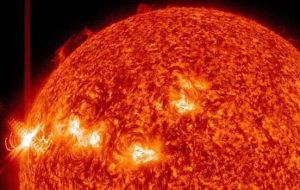MercoPress. South Atlantic News Agency
Solar activity at its 11-year peak; major flares could impact Earth over the weekend
 Supercharged streams of solar material have missed the Earth because the active region on the sun (AR1748) isn't pointing in our direction.
Supercharged streams of solar material have missed the Earth because the active region on the sun (AR1748) isn't pointing in our direction. Between Sunday and Monday, and within a 24 hour period, the sun has let lose three major flares, all in the X range. Solar flares are rated on a scale with X flares being among the largest possible. The latest flare erupted Monday night and registered as an X3.2, which is so far the most powerful solar flare of 2013.
The flares are emanating from a dark region on the sun known popularly as a “sunspot.” This sunspot region has been dubbed AR1748. Sunspots are dark because they are cooler than the surrounding region, however they remain amazingly hot. They are formed when magnetic field lines get twisted together. When those magnetic lines twist too much, they break, and often result in a solar flare.
Of the past three major flares, two have produced coronal mass ejections which mean some of the sun's material was flung far out into space, away from the sun at millions of miles per hour.
So far, these supercharged streams of solar material have missed the Earth because the active region on the sun (AR1748) isn't pointing in our direction. This will change within the next few days as the sun rotates.
By the end of this week, AR1748 will face Earth and any coronal mass ejections will probably impact the planet. Such impacts cause geomagnetic storms, which are responsible for displays of the northern and southern lights, also known as auroras.
While auroras are beautiful to watch, the solar events that cause them can be dangerous both in space and on Earth. Spacecraft and high-flying airliners can be exposed to increased radiation. Satellites and power grids on Earth are also susceptible to damage as electrical charges build up upon them. Satellites can be lost and power can be knocked out on Earth.
All this can be fixed however, and the only humans that are in real danger are those in orbit. Those flying are exposed to little more radiation than they receive during x-ray exams. Fortunately, the impact of a coronal mass ejection can be predicted and astronauts can take precautions while the rest of us on Earth are protected by the planet's magnetic field.
For most people, a geomagnetic storm simply means the rare treat of the northern or southern lights at middle latitudes.
The current spate of activity is normal for the sun as it reaches the climax of its 11-year cycle of activity. Every 11 years, the sun experiences increased activity as its magnetic field reverses. Then, the activity subsides and the sun remains quiet for the better part of the next decade.
What is most unusual about the current upsurge in activity is that the sun has been abnormally quiet for the past two years, well at the lower range of average activity.
Scientists cannot predict if the sun will send a coronal mass ejection towards Earth within the next several days, but they do believe there will be more activity from the AR1748. If a major geomagnetic storm appears likely, we will provide additional coverage.




Top Comments
Disclaimer & comment rulesCommenting for this story is now closed.
If you have a Facebook account, become a fan and comment on our Facebook Page!